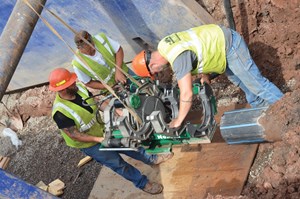Plastics Pipe Institute publishes technical document on HDPE pipe use in seismic sensitive areas
(UI) — The Municipal Advisory Board (MAB) of the Plastics Pipe Institute Inc. (PPI) has published a new technical document that provides data for high-density polyethylene (HDPE) water lines in earthquake sensitive areas, the organization announced on Feb. 9.
MAB-9, Design of HDPE Water Mains for the Lateral Spread Seismic Hazard is available for free on the group’s website.
“This is the first document of its kind that provides the rationale, data and formulas for determining the proper wall thickness for a fused, highly ductile, flexible HDPE water main in a seismically sensitive area, subjected to an induced lateral spread,” said Camille George Rubeiz, co-chair, Municipal Advisory Board and senior director of engineering, Municipal and Industrial Division of PPI.
MAB serves as an independent, non-commercial adviser to the Municipal & Industrial Division of PPI, the major North American trade association representing the plastic pipe industry.
The MAB-9 Task Group was made up of industry experts who volunteered their time. It was headed by Michael O’Rourke, Ph.D., P.E., F.SEI, M.ASCE, professor emeritus civil engineering, Rensselaer Polytechnic Institute (Troy, NY).
“Experience suggests that high-density polyethylene pipe does very well in earthquakes,” O’Rourke said. “But, engineers like to have ways to calculate and substantiate their design…The goal is to have HDPE pipe that will be able to withstand the expected earthquake loads on this inherently ductile material. With that in mind, MAB thought it would be useful to develop a document that provides designers with some relationships, tables, formulas, et cetera, that they can use to figure out how thick the wall would need to be for an expected lateral spread. And that's the purpose of the MAB-9.”
He added: “HDPE is known as a continuous pipe, which means the pipe segments, which are 40 feet to 50 feet long, are fused together. The ductile iron or cast iron pipe has joints every 15 or 20 feet, and the damage from a seismic event frequently occurs at those joints. Continuous pipe, whether it's welded steel or high-density polyethylene, usually does better than segmented pipe in earthquakes. HDPE has the added advantage over steel (and all other materials) in that it is highly ductile, flexible and corrosion resistant and so it can move with the earth as opposed to trying to resist the deformations that the earth is imposing on it.”
Related News
From Archive

- Glenfarne Alaska LNG targets late-2026 construction start for 807-mile pipeline project
- U.S. water reuse boom to fuel $47 billion in infrastructure spending through 2035
- $2.3 billion approved to construct 236-mile Texas-to-Gulf gas pipeline
- Major water pipe break in Puerto Rico hits over 165,000 customers
- Potomac River Tunnel project enters construction phase beneath Washington, D.C.
- Pennsylvania American Water launches interactive map to identify, replace lead water service lines
- Trump's tariffs drive $33 million cost increase for Cincinnati sewer project
- Utah city launches historic $70 million tunnel project using box jacking under active rail line
- Tulsa residents warned after sewer lines damaged by boring work
- Fatal trench collapse halts sewer construction in Massachusetts; two workers hospitalized




Comments